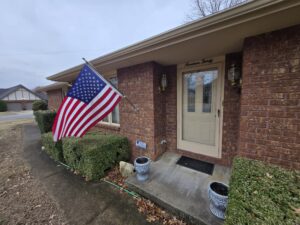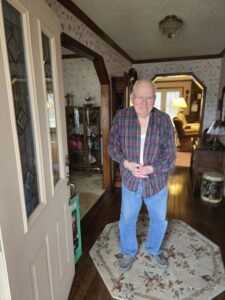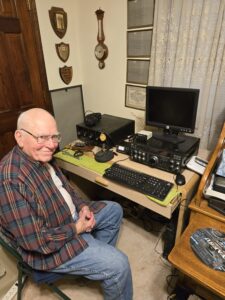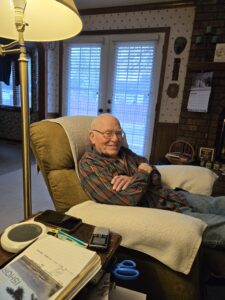 A Conversation with Jim Johannes, N0ZSQ: A Life of Aviation, Technology, and Amateur Radio
A Conversation with Jim Johannes, N0ZSQ: A Life of Aviation, Technology, and Amateur Radio
By Chris Hunt, N0YH
January 31, 2025
It was a beautiful winter day as I sat down with Jim Johannes, N0ZSQ, at his home. A man with a fascinating history, Jim’s journey spans aviation, computer technology, and decades of amateur radio experience. Today, he shares his story with us.
Family Roots and Early Life
Jim’s great-great-grandfather hailed from Prussia, a region that later became East Germany. He immigrated to Cook County, Chicago, with his three sons around 1868, just a few years before the devastating Great Chicago Fire of 1871.
“One of his sons stayed in Chicago and became a carpenter,” Jim recalls. “Unfortunately, he later fell from a scaffold and was killed. My grandfather and the other two sons moved to Iowa.”
Born on August 13, 1931, Jim entered the world in Corning, Iowa, during a home birth on the family farm. He lived on several different farms in Southwest Iowa over the years finally ending up in Neola. After finishing 8th grade his family moved to Denver due to concerns over his father’s health with Tuberculosis. After visiting a second physician in Denver it was discovered that his father was in good health, and the family decided to stay in Colorado.
 Military Service and Aviation Career
Military Service and Aviation Career
In 1949, Jim joined the U.S. Air Force and trained as a ground radio mechanic. He was stationed at Kirtland Air Force Base in Albuquerque after receiving training at Ft. Scott Air Force base to become a ground and airborne radio mechanic. He later left Kirtland AFB and transferred to Japan on the northern island of Hokkaido on a radar site near the town of Rumori.
“One time, a Beech C-35 was struggling to find the low-frequency range during a storm,” Jim recalls. “I helped him navigate away from the mountains and land safely at Kirkland. The pilot, a Major, was so grateful that he called my squadron commander to thank him for saving his life.”
Jim served for three years, four months, and one day, officially discharged on January 20, 1953—the day President Eisenhower was inaugurated.
After his military service, Jim initially considered a career in forestry but lacked the funds for school. Instead, he attended the Spartan School of Aeronautics in Tulsa, where he became the first person to complete their Flight Engineer training and received his license. He was hired immediately and began flying DC-6s and DC-7s.
“In 1962, American Airlines closed their Boston base,” Jim explains. “I was eligible for Elektra aircraft training, but I didn’t want to move to New York. With a young son at home, we decided to settle in Dallas-Fort Worth instead.”
A Shift to Computers
In 1962, Jim transitioned from aviation to the computer industry, working for IBM and later a startup company in Tulsa. Over the course of 55 years, he became an expert in computer hardware, witnessing the industry’s rapid evolution.
 Discovering Amateur Radio
Discovering Amateur Radio
Jim’s introduction to amateur radio came in 1975 when his son, then 13 years old, became deeply involved in the hobby. “He had a photographic memory and quickly earned his Novice, General, and Advanced licenses,” Jim says. “He went from Novice to Advanced in less than a year. He just ate up code. I bought him a Heathkit 101, taught him to solder, and he only had 1 component wrong. He was a natural at CW, and 10-meter was his favorite band.”
Although Jim was exposed to amateur radio early on, he didn’t obtain his own license until November 1993, testing in Carthage, Missouri. He remained a Technician until 2017 when he upgraded to General after they removed the code requirements. “I never had a need for Extra,” he admits.
Memorable Contacts and Digital Modes
Jim has logged 119 countries, including rare DX contacts such as northwest China, South Korea, and Kenya. “My most memorable contact was northwest China on FT8,” he shares. “I received a beautiful QSL card from them.”
He enjoys digital modes, having started with PSK before moving to FT8. “I like FT8 because it allows me to work DX efficiently,” he says. “I’ve also worked all six Canadian provinces and 46 U.S. states.”
Reflections on the Hobby
Jim believes the biggest change in amateur radio has been the integration of computers. “It’s completely transformed the hobby,” he observes.
As for the future, he sees promise in youth engagement. “I’m glad to see programs that get young people involved, like the Youth Net on Tuesday mornings. It reminds me of how my son got started.”
Advice for New Hams
Jim emphasizes the importance of mentorship. “Find a good Elmer,” he advises. “You need guidance to learn and grow in the hobby. I was lucky to have Jim Scott help me with my questions.”
 Final Thoughts
Final Thoughts
Jim and his wife have moved 26 times during their marriage, but he has called Joplin his home since 1988.
“I’ve been around a lot,” he says with a smile. “When I attended my first Joplin Amateur Radio Club meeting in 1993, we had nearly 100 members.”
Despite the changes over the years, Jim remains passionate about amateur radio. “I enjoy FT8 and chasing DX,” he says. “It’s a hobby that keeps evolving, but at its core, it’s still about making connections.”
Thank you, Jim, for sharing your story with us. 73!
(Hear the complete 1-hour interview here… N0ZSQ Audio Interview Sorry for the audio quality. The mic was a little hot.)